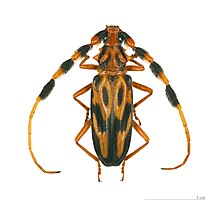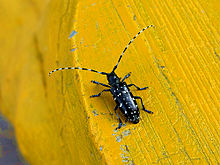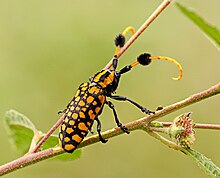Longhorn beetle
| Cerambycidae Temporal range:
| |
|---|---|

| |
| Batus barbicornis | |
| Scientific classification | |
| Domain: | Eukaryota |
| Kingdom: | Animalia |
| Phylum: | Arthropoda |
| Class: | Insecta |
| Order: | Coleoptera |
| Infraorder: | Cucujiformia |
| Superfamily: | Chrysomeloidea |
| Family: | Cerambycidae Latreille, 1802 [1] |
| Subfamilies | |
|
Eight; see text | |
The longhorn beetles (Cerambycidae), also known as long-horned or longicorns (whose larvae are often referred to as roundheaded borers), are a large family of beetles, with over 35,000 species described.[2]
Most species are characterized by
Longhorn beetles are found on all continents except Antarctica.[3]
Description
Other than the typical long antennal length, the most consistently distinctive feature of adults of this family is that the antennal sockets are located on low tubercles on the face; other beetles with long antennae lack these tubercles, and cerambycids with short antennae still possess them. They otherwise vary greatly in size, shape, sculpture, and coloration. A number of species mimic
Larvae are 0.5–22 cm (0.20–8.66 in) long, elongate in shape and lightly sclerotised. The prothorax is often enlarged and the sides of the body have lateral swellings (ampullae). The head is usually retracted into the prothorax and bears well-sclerotised mouthparts. Larval legs range from moderately developed to absent. The spiracles are always annular.[5]

Biology

Diet
All known longhorn beetle larvae feed on plant tissue such as stems, trunks, or roots of both herbaceous and woody plants, often in injured or weak trees.
Many longhorns locate and recognize potential hosts by detecting
Pollination
In addition to feeding on other plant tissue, some species feed on pollen or nectar and may act as pollinators. Assessing the efficacy of beetle pollinators is difficult. Even if pollination of one species by beetles is shown, that same beetle may also act as a flower predator toward other species. In some cases, beetles may act as both pollinators and predators on the same flowers.[9]
Flowers specializing in pollination by beetles typically display a
Beetles in the New Zealand genus
Some orchid species have been found to be largely reliant on longhorn beetles for pollination. The species Alosterna tabacicolor was found to be the main pollinator of a rare orchid species (Dactylorhiza fuchsii) in Poland.[13] Another rare orchid Disa forficaria, found in the Cape Floristic Region in South Africa, relies on the species Chorothyse hessei for pollination. D. forficaria uses sexual deception targeting male C. hessei, possibly indicating a long history of co-evolution with longhorn beetle pollinators.[14]

The proportion of longhorn beetle species that act as pollinators is unknown. The fact that two species of longhorn species from distinct subfamilies (Lepturinae and Cerambycinae) found on different continents both with significant roles as pollinators could suggest that some capacity for pollination may be common among longhorn beetles.
Predators
Parasitoids
In
Classification

As with many large families, different authorities have tended to recognize many different subfamilies, or sometimes split subfamilies off as separate families entirely (e.g., Disteniidae, Oxypeltidae, and Vesperidae);[16] there is thus some instability and controversy regarding the constituency of the Cerambycidae.[17] There are few truly defining features for the group as a whole, at least as adults, as there are occasional species or species groups which may lack any given feature; the family and its closest relatives, therefore, constitute a taxonomically difficult group, and relationships of the various lineages are still poorly understood.[18] The oldest unambiguous fossils of the family are Cretoprionus and Sinopraecipuus from Yixian Formation of Inner Mongolia and Liaoning, China, dating to the Aptian stage of the Early Cretaceous, approximately 122 million years ago. The former genus was assigned to the subfamily Prioninae in its original description, while the latter could not be placed in any extant subfamily.[19][20] Qitianniu from the mid-Cretaceous Burmese amber of Myanmar, dating to approximately 100 million years ago, also could not be placed in any extant subfamily.[21]


Subfamilies
The eight subfamilies are:[22][23]
- Cerambycinae Latreille, 1802
- Dorcasominae Lacordaire, 1869 (including former Apatophyseinae Lacordaire, 1869)
- Lamiinae Latreille, 1825
- Lepturinae Latreille, 1802
- Necydalinae Latreille, 1825
- Parandrinae Blanchard, 1845
- Prioninae Latreille, 1802
- Spondylidinae Audinet-Serville, 1832 (including former Aseminae Thomson, 1860)
Most species (90.5%) are concentrated in the Cerambycinae and Lamiinae subfamilies.[3]
Notable genera and species

- Acrocinus longimanus– harlequin beetle, a large species where the male has very long front legs
- Anoplophora chinensis– citrus long-horned beetle, a major pest
- Anoplophora glabripennis– Asian long-horned beetle, an invasive pest species
- Aridaeus thoracicus – tiger longicorn (Australia)
- Cacosceles newmannii - Southern African longhorn beetle that is a surgacane pest
- Desmocerus californicus dimorphus– valley elderberry longhorn beetle, a threatened subspecies from California
- Moneilema – cactus longhorn beetles, which are flightless
- Onychocerus albitarsis – the only known beetle with a venomous sting
- Petrognatha gigas– giant African longhorn beetle
- Prionoplus reticularis– huhu beetle, the heaviest beetle in New Zealand
- Rosalia alpina– Rosalia longhorn beetle, a threatened European species
- Stictoleptura rubra – red-brown longhorn beetle
- Tetraopes tetrophthalmus – red milkweed beetle, a toxic species with aposematic colors
- Tetropium fuscum – brown spruce longhorn beetle, an invasive pest species
- Titanus giganteus– titan beetle, one of the largest beetles in the world
- Zorion guttigerum - flower long-horn beetle, an important pollinator species.
See also
- List of longhorn beetle (Cerambycidae) species recorded in Britain
- List of beetles of Nepal (Cerambycidae)
References
- ^ "Cerambycidae Latreille, 1802". Integrated Taxonomic Information System. Retrieved June 6, 2011.
- ^ "The first long-horned beetle giving birth to live young discovered in Borneo". Science Daily. 11 May 2016. Retrieved 14 June 2021.
- ^ ISSN 2475-0263.
- ^ Barclay, Max (2010). "Titanus giganteus Linnaeus (1771)". Natural History Museum. Retrieved June 6, 2011.
- ^ "Wood Boring Beetle Families - Cerambycidae". idtools.org. Retrieved 2023-02-06.
- ISSN 2320-7078.
- S2CID 1995065– via ResearchGate.
- – via ResearchGate.
- ISBN 978-3-7091-7076-2, retrieved 2023-10-18
- ISBN 978-3-7091-6306-1, retrieved 2023-10-18
- ISSN 1175-5334.
- ^ "Meet our pollinators | EPA". www.epa.govt.nz. Retrieved 2023-10-17.
- ISSN 0006-3207.
- ISSN 0024-4066.
- ^ a b "PPQ Scientists Evaluate Wasp's Ability to Detect and Attack the Asian Longhorned Beetle". PPQ (Plant Protection and Quarantine). USDA APHIS. Retrieved 2021-09-07.
- ISBN 84-922495-8-7.
- ISBN 1-877407-96-8.
- ^ Arnett, et al. (2002). American Beetles, Vol. 2. CRC Press, 861 pp.
- S2CID 86312026.
- .
- .
- PMID 21594053. Archived from the originalon 2011-07-21.
- ISBN 978-3-11-027446-2.
Further reading
- Monné, Miguel A. & Hovore, Frank T. (2005) Electronic Checklist of the Cerambycidae of the Western Hemisphere. PDF Cerambycids.com
External links
- Photo gallery "Longhorn beetles (Cerambycidae) of the West Palaearctic Region"
- [1] and [2] Catalogs of New World and Old World Cerambycidae, respectively
- Cerambycidae of French Guiana
- National Museu, Rio, Brazil Holotype images
- Iberodorcadion Coleoptera, Cerambycidae, Dorcadion - RedIRIS
- VIDEOS - Longicornes (Dorcadion, Cerambycidae, Coleoptera)
- Cerambycidae of Borneo pdf
- BugGuide.net - Longhorned Beetles (Cerambycidae)
- Anoplophora chinensis, citrus longhorned beetle on the University of Florida / Institute of Food and Agricultural Sciences Featured Creatures website
- Coleoptera: Cerambycidae, University of Florida, Dept. of Entomology and Nematology
- Wood-boring beetles of the World
- [3]
